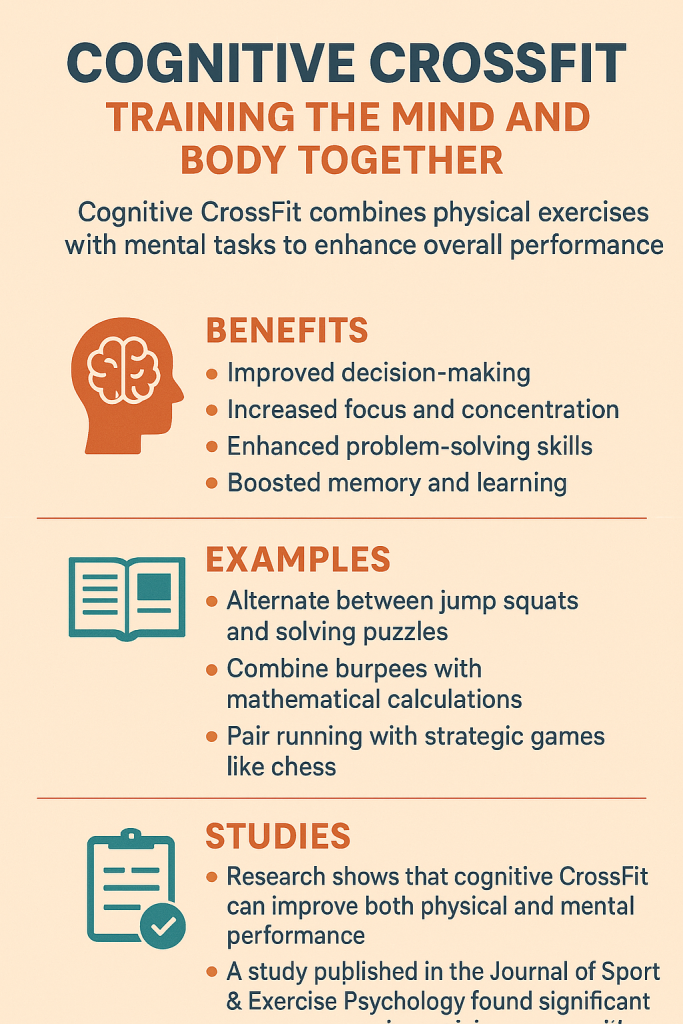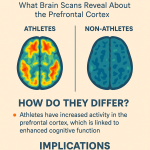Cognitive CrossFit – Training Mind and Body Together
Cognitive CrossFit: training the mind and body together is emerging as a revolutionary approach to human performance. The idea is simple yet profound—just as CrossFit combines strength, endurance, and flexibility to create well-rounded athletes, Cognitive CrossFit integrates mental and physical training to sharpen decision-making, resilience, and focus. This approach isn’t only for elite athletes—it’s for entrepreneurs, students, professionals, and anyone seeking to maximize their brain and body’s potential.
The first 100 words focus on this synergy because Cognitive CrossFit is more than a workout—it’s a philosophy. By combining physical exercise with cognitive drills, individuals can unlock peak mental clarity, regulate emotions under stress, and strengthen executive function. In this guide, we’ll explore the science, practical exercises, and real-world benefits of Cognitive CrossFit, showing how training both mind and body together creates unstoppable momentum for success.
What is Cognitive CrossFit?
Cognitive CrossFit is a framework that blends physical training with cognitive challenges in a way that enhances performance on both fronts. Unlike traditional workouts that focus only on the body, or mental training that isolates the brain, Cognitive CrossFit unites the two. For example:
- Performing memory recall tasks while sprinting
- Solving logic puzzles between weightlifting sets
- Practicing mindfulness in high-intensity workouts
- Balancing agility drills with reaction-time tasks
This combination trains the prefrontal cortex (responsible for decision-making and impulse control) while improving physical endurance, creating a holistic model of human performance.
The Science Behind Cognitive CrossFit
Neuroplasticity in Action
Exercise triggers neuroplasticity, the brain’s ability to rewire itself. Combining cognitive tasks with movement amplifies this effect, reinforcing pathways that control focus, memory, and executive function.
Exercise and Brain Chemistry
Physical activity increases levels of BDNF (Brain-Derived Neurotrophic Factor), which fuels brain growth. Pairing this with problem-solving ensures that new neurons are immediately engaged in cognitive activity, locking in sharper skills.
Stress Regulation
The prefrontal cortex and amygdala work together to regulate stress. Studies show that exercise reduces cortisol, while cognitive training strengthens control over emotional responses. Together, they create resilience under pressure.
Reaction Time and Decision-Making
Research from the Journal of Cognitive Neuroscience found that dual-task training (exercise + mental tasks) significantly improves reaction speed and accuracy. This is especially beneficial for athletes, soldiers, and professionals in high-stakes environments.
Benefits of Cognitive CrossFit
- Sharper Decision-Making: Integrating mental drills into workouts improves executive function, making it easier to evaluate risks and rewards quickly.
- Boosted Focus and Attention: Cognitive challenges during training sharpen concentration and reduce susceptibility to distractions.
- Emotional Resilience: Training under simulated stress (physical exertion + mental tasks) builds composure in real-world challenges.
- Enhanced Memory and Learning: Combining exercise with memory tasks improves long-term retention, as shown in studies on exercise-induced neurogenesis.
- Stronger Physical Fitness: Mental challenges don’t replace physical intensity—they enhance it by keeping workouts engaging and purposeful.
Studies Supporting Cognitive CrossFit Principles
- University of Illinois Study: Found that children who engaged in physical activity paired with cognitive challenges scored higher in executive function tests.
- Harvard Medical School Research: Exercise boosts neurogenesis in the hippocampus, the brain’s memory hub, amplifying learning when paired with mental tasks.
- Frontiers in Human Neuroscience (2019): Dual-task training improved reaction times and working memory in older adults, proving benefits extend across age groups.
- Nature Neuroscience Review: Highlighted that aerobic exercise strengthens prefrontal cortex pathways, supporting sharper focus and impulse control.
Cognitive CrossFit in Action: Examples
Military Training
Elite military units combine obstacle courses with decision-making simulations, forcing soldiers to think strategically under physical strain.
Sports Performance
Athletes like soccer players practice cognitive drills during practice (e.g., solving equations while dribbling) to sharpen split-second decisions on the field.
Entrepreneurship
High-level executives practice mindfulness and physical training together, helping them maintain focus and creativity during demanding schedules.
Education
Schools introducing movement-based learning (like standing desks or kinesthetic classrooms) see better academic outcomes due to stronger brain-body integration.
Practical Cognitive CrossFit Exercises
- Memory Burpees: Recall a sequence of numbers or words after every 10 burpees.
- Puzzle Sprints: Solve a Sudoku or riddle during 60-second rest intervals in sprint training.
- Reaction Ball Drills: Use reaction balls for agility, combining motor skills with attention challenges.
- Mindful Weightlifting: Focus intently on breathing, posture, and visualization while lifting.
- Dual-Task Circuits: Alternate between high-intensity exercises and quick-fire mental arithmetic.
Building a Cognitive CrossFit Routine
Step 1: Warm-Up with Mindfulness
Start with 5 minutes of meditation or deep breathing to prime the prefrontal cortex.
Step 2: Physical Intensity
Include high-intensity intervals (sprints, circuits, kettlebells) to elevate heart rate and oxygen flow.
Step 3: Mental Challenges
Layer cognitive tasks like memory recall, puzzles, or language drills during rest periods.
Step 4: Cool Down with Reflection
Journal, visualize, or perform gratitude practice to solidify mental gains.
Cognitive CrossFit for Professionals
In the workplace, Cognitive CrossFit translates into:
- Sharper Meetings: Faster decision-making and problem-solving.
- Stress Reduction: More resilient responses to deadlines.
- Creative Innovation: Enhanced divergent thinking through mental-physical synergy.
- Team Performance: Group workouts with mental challenges foster collaboration and focus.
Who Can Benefit from Cognitive CrossFit?
- Athletes: For sharper in-game decisions and emotional control.
- Students: To boost memory, focus, and learning capacity.
- Professionals: For clearer thinking and reduced burnout.
- Older Adults: To protect brain health and slow cognitive decline.
- Entrepreneurs: For resilience, creativity, and long-term performance.
Common Misconceptions
- “It’s only for athletes.” In reality, Cognitive CrossFit benefits anyone who combines mental and physical challenges.
- “It replaces traditional workouts.” It enhances them, adding a layer of cognitive engagement.
- “It’s too complex.” Even simple activities like reciting affirmations during a jog count as Cognitive CrossFit.
The Future of Cognitive CrossFit
As neuroscience and fitness merge, we can expect:
- Apps and Wearables: Devices that integrate heart rate, cognitive tasks, and brainwave monitoring.
- Workplace Wellness Programs: Offices adopting brain-body fitness to enhance productivity.
- Education Systems: Schools weaving physical-cognitive challenges into daily curricula.
- Sports Training: More athletes using neuro-fitness drills as part of standard training.
Infographic: Cognitive CrossFit at a Glance
Title: Train Mind and Body Together
- Exercise + Mental Tasks = Stronger Brain and Body
- Boosts: Decision-making, Focus, Resilience, Creativity
- Examples: Memory burpees, puzzle sprints, mindful lifting
- Backed by: Harvard, Illinois, and neuroscience studies
Conclusion: Why Cognitive CrossFit Matters
Cognitive CrossFit—training the mind and body together—offers a blueprint for human optimization. The research is clear: when you combine physical exertion with mental challenges, you supercharge both. Athletes make better decisions, professionals handle stress with more resilience, and students retain more knowledge. Whether you’re sprinting, lifting, or meditating, integrating cognitive elements transforms a workout into brain-body training.
In today’s demanding world, success isn’t just about strength or intelligence—it’s about synergy. By embracing Cognitive CrossFit, you can build not only a fitter body but also a sharper, more resilient mind. The future of fitness is holistic, and it starts with training both sides of human potential together.
What Japanese Brain-Scan Research Reveals About Gymnast Neuroplasticity
An illuminating study reported by The Asahi Shimbun reinforces this deep dive into neuroplastic changes in Olympic-level gymnasts—which aligns perfectly with our core topic.
Researchers led by Hidefumi Waki at Juntendo University conducted MRI scans on 10 male gymnasts with world-class credentials and compared them to a control group of non-athlete males. Strikingly, certain regions of the gymnasts’ cortex were about 10% larger—notably the precentral gyrus (motor function) and the inferior parietal lobule (involved in spatial perception and sensory integration) 朝日新聞.
Furthermore, the team discovered that athletes with higher average competition scores tended to have larger volumes in the inferior parietal lobule, suggesting that long-term training reshapes brain regions tied to spatial and sensory processing 朝日新聞. Interestingly, no regions were found to be smaller, underscoring that these adaptations appear to be built—not traded off.
Waki notes that gymnasts’ ability to make split-second body adjustments—even before initiating movement—is central to their expertise 朝日新聞. These insights dovetail with our discussion on prefrontal recalibration, motor-visual integration, and the emergence of autopilot-like performance in elite athletes.
Shaolin monks brain scan research not only highlights incredible focus and resilience but also connects deeply to modern health and wellness practices. Their disciplined lifestyle—balancing meditation, movement, and mindfulness—shows us how ancient wisdom aligns with today’s science-backed approaches to stress management, emotional regulation, and overall well-being.



